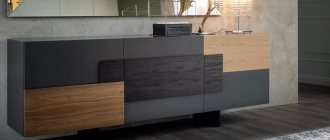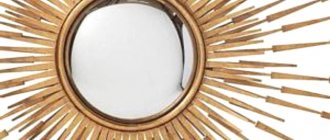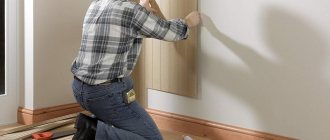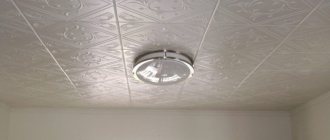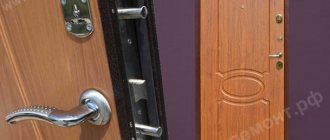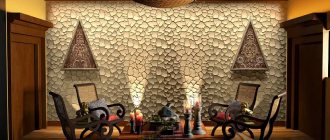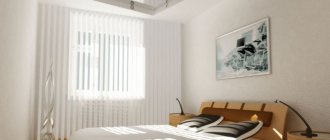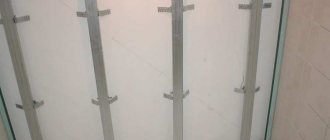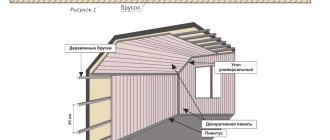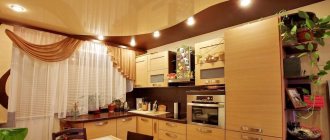in the ceiling section.
But what to do if you need to install an LED panel in a suspended ceiling?
The first method is to install the LED panel in suspended ceilings using a set of mounting brackets on springs.
A unique mounting system turns a conventional LED panel into a recessed ceiling light with spring-loaded lugs. This simplifies the installation of the lamp and solves many lighting problems.
The kit includes 4 springs on brackets + screws, thanks to which the panel is securely held on the ceiling.
Instructions for installing LED panels in a suspended ceiling using mounting brackets
1. Remove the corner screws on the back of the LED panel.
2. Install the bracket on the spring from the kit and screw the screw back in, securing the mounting bracket to the panel.
The mounting screws must be inserted through the center hole. Install all 4 mounting brackets in the same way.
3. Connect the LED panel driver. The driver must be mounted in a remote location. This will provide access to the device.
Now you need to prepare the mounting hole into which the panel will be installed. To do this, mark the entry points of the fastening brackets on the canvas and strengthen the film with O-rings.
After this, you can cut a hole for the future lamp. Then, carefully bend the 4 clips with springs and insert the LED panel into the pre-prepared mounting hole.
Second installation method.
The second method allows you to install the lamp in the same plane as the suspended ceiling. To do this, you need to use cable suspensions .
Instructions for installing LED panels using cable hangers.
Markings are made on the rough ceiling according to the size of the lamp. At the designated points, holes are made for fastening the cable suspension, which is fixed with self-tapping screws on plastic dowels (dowel and nail).
After this, the ceiling is stretched, the exit points of the suspensions are marked on the canvas and the film is strengthened with O-rings. Now you can cut a hole for the future lamp.
Cable suspensions make it possible to adjust the height of the lamp; it can easily be fixed at the level of the tension surface.
Can LED ceiling panels be used under a suspended ceiling? Features of the design solution of these products. Advantages and disadvantages of LED ceiling units. Classification and configuration of devices. Installation features. Recommendations for choosing a product.
LED ceiling panels are ideal for suspended ceilings, or rather for installation in this type of ceiling covering.
Fasteners in drywall
With a plasterboard ceiling, you can choose two methods of fastening. The first is when the power supply is retracted from the ceiling (if there is enough space for this).
A short wall-to-ceiling mount kit is used here.
The second is when the power supply is attached to the ceiling itself, or simply placed on the panel from above. Provided that there is no free space behind the ceiling.
Here you already need a long wall-ceiling fastener.
Large sizes of LED panels can be fixed in an original way. Glue metal washers to the corners of the lamp on the back side.
And attach neodymium magnets to the ceiling in any available way.
It is desirable that they have a hole in the middle. Then there will be more options for fastening.
Such magnets, despite their miniature size, can easily withstand a weight of several kilograms.
The main problem is how to get the wires out for connection. Therefore, many people install them in places where there was already a lamp, only of a different design.
Design Features
This lighting device is housed in a durable aluminum housing, characterized by low thermal conductivity. The diodes themselves are placed around the perimeter of the device frame. Light from the diodes passes through the end part of the lenses with laser notches. A special light-reflecting film is installed immediately behind the lens, which directs the light flux at right angles to the main plane of the device.
The device is equipped with an additional diffuser, which helps to obtain a uniform, even glow over the entire plane of the unit. To produce this part of the device, a special metal with high light-conducting ability is used.
The body of the unit is designed in such a way that when it is built into a suspended ceiling, the front side of the frame is flush with the suspended surface. The unit itself is attached to the concrete ceiling using special hangers that allow you to adjust the distance to the tension surface.
Pros and cons of LED panels
LED panels for suspended ceilings are gaining unprecedented popularity. All this thanks to a large list of advantages:
- The unit consumes a minimum of electricity, which makes it the leader in efficiency among lighting devices.
- The durability of the lamp is another undeniable plus in its favor. According to the manufacturers, the unit is capable of operating for 50,000 hours.
- Thanks to the built-in transformer, the device emits a uniform, flicker-free light flux, which has the best effect on our vision.
- The device is able to maintain balance, that is, if one of the diodes becomes inoperative, the intensity and uniformity of lighting will not suffer at all.
- Simple and quick installation allows you to do it yourself.
- The unit can be used in any room, since there is no need to frequently change light bulbs.
- LED panels can emit light of different colors. Thanks to this, it is easy to perform functional zoning of the room.
- Panels can be built-in or wall-mounted. Since the height of the body does not exceed 8-25 mm, the built-in unit does not require a large gap between the suspended ceiling and the base surface, and the mounted device does not reduce the height of the room.
- The beauty and practicality of the product are its important advantages.
LED ceiling panels for suspended ceilings
Can LED ceiling panels be used under a suspended ceiling? Features of the design solution of these products. Advantages and disadvantages of LED ceiling units. Classification and configuration of devices. Installation features. Recommendations for choosing a product.
LED ceiling panels are ideal for suspended ceilings, or rather for installation in this type of ceiling covering.
Design Features
This lighting device is housed in a durable aluminum housing, characterized by low thermal conductivity. The diodes themselves are placed around the perimeter of the device frame. Light from the diodes passes through the end part of the lenses with laser notches. A special light-reflecting film is installed immediately behind the lens, which directs the light flux at right angles to the main plane of the device.
The device is equipped with an additional diffuser, which helps to obtain a uniform, even glow over the entire plane of the unit. To produce this part of the device, a special metal with high light-conducting ability is used.
The body of the unit is designed in such a way that when it is built into a suspended ceiling, the front side of the frame is flush with the suspended surface. The unit itself is attached to the concrete ceiling using special hangers that allow you to adjust the distance to the tension surface.
Pros and cons of LED panels
LED panels for suspended ceilings are gaining unprecedented popularity. All this thanks to a large list of advantages:
- The unit consumes a minimum of electricity, which makes it the leader in efficiency among lighting devices.
- The durability of the lamp is another undeniable plus in its favor. According to the manufacturers, the unit is capable of operating for 50,000 hours.
- Thanks to the built-in transformer, the device emits a uniform, flicker-free light flux, which has the best effect on our vision.
- The device is able to maintain balance, that is, if one of the diodes becomes inoperative, the intensity and uniformity of lighting will not suffer at all.
- Simple and quick installation allows you to do it yourself.
- The unit can be used in any room, since there is no need to frequently change light bulbs.
- LED panels can emit light of different colors. Thanks to this, it is easy to perform functional zoning of the room.
- Panels can be built-in or wall-mounted. Since the height of the body does not exceed 8-25 mm, the built-in unit does not require a large gap between the suspended ceiling and the base surface, and the mounted device does not reduce the height of the room.
- The beauty and practicality of the product are its important advantages.
The only drawback is the low moisture resistance of the device, so it cannot be installed in rooms with high humidity levels.
Types of LED panels
LED panels for suspended ceilings are produced in round, square and rectangular shapes. To order, you can make a device of a different, non-traditional shape, but its price will be slightly higher than that of serial units.
Typically, the panel height is only 1.4 cm. The device uses a matte diffuser, which allows you to visually increase the height of the room. As you already understood, the unit can be built-in or mounted.
In addition, these products are classified according to the level of power consumption, as well as the color of the emitted light flux. The lamp power is directly related to the number of diodes located within the light plane of the unit. This indicator can range from 10 to 100 diodes.
Device equipment and power supply features
When purchasing a device, in addition to the unit itself, you can buy:
- Power supply with stabilizer
- Ceiling Mounting Hardware
Typically, the power supply is designed for a power range from 110 to 240 W. It has devices that protect the unit from short circuits. When purchasing a lamp, you can count on a warranty that applies not only to the unit itself, but also to the power supply.
Installation features
There are two ways to install this unit:
- The device is built into a suspended ceiling covering
- LED ceiling panels are mounted under a suspended ceiling (hung)
Depending on the distance between the tension covering and the base ceiling, either ceiling rails (wooden beams) or adjustable hangers can be used to mount the device.
Tips for choosing
- To illuminate the room with uniform light, it is better to buy panels with a luminous flux of neutral colors.
- To perform functional zoning, it is enough to use alternating panels of dark and light colors.
- To visually lengthen the room, you can place the devices one behind the other in the longitudinal direction of the room.
- If you need, on the contrary, to reduce the length of the room, then the panels are placed one after another across the room.
- Lighting fixtures placed in a chaotic manner give the room originality and originality.
- When installing LED panels in a low room, you can visually increase its height. If you attach panels to the ceiling of a high room, then it acquires aristocracy and respectability.
- The panels fit harmoniously into the modern, high-tech, loft and minimalist styles.
- Using ultra-thin Japanese-style LED panels, you can achieve the effect of skylights.
- If you want to use panels in a classic interior or in a room decorated in the Empire or Baroque style, then it is better to use them only as auxiliary lighting, since large decorative items are not typical for these styles.
As you can see, modern panels with diode lighting can act as main and auxiliary lighting sources. They allow you not only to illuminate the room, but also to decorate it. You can contact us by phone and order the installation of a stretch ceiling with suspended or built-in LED panels.
potolokino.ru
Types of LED panels
LED panels for suspended ceilings are produced in round, square and rectangular shapes. To order, you can make a device of a different, non-traditional shape, but its price will be slightly higher than that of serial units.
Typically, the panel height is only 1.4 cm. The device uses a matte diffuser, which allows you to visually increase the height of the room. As you already understood, the unit can be built-in or mounted.
In addition, these products are classified according to the level of power consumption, as well as the color of the emitted light flux. The lamp power is directly related to the number of diodes located within the light plane of the unit. This indicator can range from 10 to 100 diodes.
Useful tips
During installation and connection of LED panels, it is important to take into account several useful notes:
- If the device contains a driver, its output terminals can be connected to a household network.
- If the device does not have a power supply, it must be purchased and installed discreetly separately from the device.
The driver or power supply must match the network voltage at the input and output (going to the LED panel), as well as the current rating, the permissible load and the required degree of protection.
Tips for choosing
- To illuminate the room with uniform light, it is better to buy panels with a luminous flux of neutral colors.
- To perform functional zoning, it is enough to use alternating panels of dark and light colors.
- To visually lengthen the room, you can place the devices one behind the other in the longitudinal direction of the room.
- If you need, on the contrary, to reduce the length of the room, then the panels are placed one after another across the room.
- Lighting fixtures placed in a chaotic manner give the room originality and originality.
- When installing LED panels in a low room, you can visually increase its height. If you attach panels to the ceiling of a high room, then it acquires aristocracy and respectability.
- The panels fit harmoniously into the modern, high-tech, loft and minimalist styles.
- Using ultra-thin Japanese-style LED panels, you can achieve the effect of skylights.
- If you want to use panels in a classic interior or in a room decorated in the Empire or Baroque style, then it is better to use them only as auxiliary lighting, since large decorative items are not typical for these styles.
Flaws
Cheap Chinese panels have one drawback that you may encounter after a year of use, or maybe earlier.
When heated, the LED strip begins to peel off from the body. Because of this, the LEDs, without coming into contact with aluminum, heat up even more and degrade.
As a result, the panel, for no apparent reason, begins to blink. If this happens, the entire ice belt will have to be replaced.
Some craftsmen, faced with such a problem, initially open the power supply and change the resistance. This reduces the current consumption and extends the service life of the LED panel significantly.
Many Chinese manufacturers can deliberately increase the current in order to increase the brightness of the lamp.
Design features of lamps
The glow of single-component LEDs occurs due to the use of phosphors. They convert ultraviolet radiation from a semiconductor crystal carrying current into light in the visible spectrum.
Light emitting diode
Most often, an LED element that consumes low voltage current is used in tape and cassette modules. The power supply for such a module from the central power grid is provided by a power supply that converts high-voltage alternating current into low-voltage direct current.
Important
! If a modular device is made with a series connection of LEDs, then if one element fails, the entire device becomes unusable.
Strip LED ceiling modules have limitations on the length of the strip that can be connected to the power supply (limitations on the total power of the LEDs in the circuit).
The modular LED lamp is closely related to the technology of suspended systems, since the dimensions of most panels are designed for installation in a standard Armstrong-type suspended ceiling cell. At the same time, the mounting systems that are equipped with the LED panel imply installation in any suspended or suspended ceiling.
Room illuminated by LED panels
The LED panel has the following design:
- A square or rectangular housing made of sheet aluminum (sometimes plastic). The area corresponds to the size of the cell, and the length of its sides is a multiple of 30 cm. The height of the case can be from 7.5 mm in ultra-thin models and up to 15 mm in regular ones.
- The LEDs inside the case are located along the perimeter closer to the outer edge. They are mounted into the holes of an acrylic sheet located inside the case. The acrylic panel has a special structure, so when passing through it, light is scattered.
- The acrylic panel is covered with a reflective film, directing the entire flow of light downwards.
- The LED lamp has a diffuser in the lower (front) part.
It is the panel with the diffuser that ensures uniform distribution of light throughout the room, preventing the appearance of shadowed areas in it.
LED ceiling panels: features and installation
LED ceiling panels gained popularity about ten years ago. And today they are actively replacing other sources of artificial lighting. The main reason is energy savings.
Today, such devices are used not only for lighting office premises, shopping centers, but also small apartments or private houses. What is the reason for the breadth of their use? Let's try to figure it out.
Design
It is represented by a metal (aluminum) or plastic case and an acrylic sheet. Holes are made in the sheet for LED elements. In this case, the brightness of the lamp depends on the number of bulbs. The sheet thickness does not exceed 8 mm. On the front side of the acrylic plate there are many small channels embossed in horizontal and vertical directions that scatter light. A reflector is installed at the back of the sheet to evenly distribute light fluxes.
The set of light panels for ceilings includes voltage stabilizers in the form of additional power supplies. Their performance is not affected in the range from 110 to 240 W.
Light panels on the ceiling mounted as part of the Armstrong structure
Installation of devices is mostly carried out on suspended plasterboard structures. But there are models that can be built under suspended ceilings or ordinary concrete foundations.
Advantages and disadvantages
The diode panel has many advantages, the main ones are:
- Consumes a small amount of electricity. The use of such devices saves 50% of energy costs.
- Gives bright, uniform light. The light output of the panel is 10 times higher than that of conventional incandescent lamps. If one of the LEDs fails, the lamp continues to work, but the light does not dim.
- Long service life. Manufacturers guarantee from 50 to 70 thousand hours of uninterrupted operation of the device, regardless of the frequency of its activation.
- It is easy to install with your own hands.
- Wide possibilities. When such lighting elements are included in the interior, you can visually divide the room into zones, emphasize the texture of the stretch fabric, and highlight textiles or furniture.
- Safe. Due to the low power consumption (12-24 W), it is impossible to receive an electric shock from contact with the lamp. In addition, these light elements do not emit harmful substances during operation or after failure.
- Low inertia. Light panels light up immediately after turning on the switch, while energy-saving or fluorescent lamps require several seconds to warm up.
- Low heat transfer. Thanks to this advantage, the devices can be installed under suspended ceilings without fear of damaging the coating due to high temperatures.
Perhaps the only drawback is the rather high cost of the products.
If you want to make the room fashionable and modern, be sure to include LED panels in the interior!
Kinds
Lighting fixtures are presented in three main variations in shape:
- Square. Usually placed in office spaces and large stores, emphasizing the status of style and interior, making them luxurious and elegant.
- Round. Most often they are used when decorating a room in a traditional style, high-tech interiors and futuristic designs. To create a single system, you can use several lighting fixtures configured to be turned on/off simultaneously or separately.
- Rectangular. These models are installed to delimit space into separate zones. You can also find wall-mounted LED panels of this type on sale, which take up a lot of space but perfectly illuminate the room. They are usually used as night lights for children's or bedrooms, as well as living rooms, to create a cozy and romantic atmosphere.
Most of the devices are produced with a maximum thickness of 1.4 cm. The sizes vary - from 20 cm to 60 cm, for round panels the diameter is 24 cm.
Based on functionality, appearance and other parameters, the division of LED panels shown in the table is also accepted:
| Peculiarity | Kinds |
| Installation method | Built-in (embedded in plasterboard structures) and overhead (fixed on fasteners in the likeness of a simple lamp) |
| Light direction | With replaceable and variable beam distribution |
| Availability of lampshades | With and without lampshades. It is better to purchase products with shades, where built-in diffusers reduce eye strain |
| Light intensity | Stable brightness or adjustable |
On a note! You can find panels that are attached to suspensions at a distance of 20-30 cm from the ceiling surface. Such devices can illuminate individual areas well.
Installation
You can install the LED panel to the ceiling using one of three mounting methods, depending on the type of finishing of the ceiling surface:
1. Built-in. Is the simplest. To secure the panel, it must be inserted into a groove made in the plasterboard or Armstrong ceiling frame and connected to the power source. Built-in installation is most often used in offices where it is necessary to place a large number of lighting fixtures.
2. Using the overhead method, you can install the panel on the ceiling or attach it to the wall. All fasteners that will be needed during the installation process are included in a single package with the device.
Holes for the mounting plate are drilled on the ceiling using pre-marked marks. In order not to fall into a hollow space, it is important to foresee the location of the device at the stage of installing a suspended or tensioned structure. The plate is attached to the dowels, then the wiring is connected. The housing is fixed with screws to the installed plate.
3. In a suspended manner, the panels must be secured to 4 steel cables mounted to the concrete floor. With their help, you need to adjust the height of the device, and then connect the power. This method is similar to installing a chandelier.
Panels and suspended ceilings
Modern designers are increasingly incorporating panels into the interior, integrating them into tension structures, due to the practicality and convenience of the products.
Installing an LED panel for a suspended ceiling is as easy as installing conventional spotlights, despite its large dimensions. The smooth surface created from the canvas and the device looks original and harmonious.
The devices fit well into low rooms thanks to the diffusers that form part of the device’s design and evenly distribute light fluxes without causing discomfort to the eyes.
A ceiling panel with LEDs is an excellent solution for any interior. By combining products of different shapes, power and colors, you can radically transform the room.
Installation of a ceiling box with lighting and LED panels video
horoshijpotolok.ru
Positive properties and disadvantages
In terms of performance characteristics, LED ceiling modules are usually compared with incandescent lamps. In many respects, the LED panel is significantly superior to them:
- Economical energy consumption.
- High light transmission coefficient (above 95%).
- The service life exceeds the life indicators of incandescent lamps by 50 times.
- The LED panel is installed simply and quickly.
- The LED lamp turns on and off instantly, as there is no inertia effect (smooth fading).
- When adjusting the brightness of the glow with conventional resistors, the luminous flux does not change the spectral characteristics (does not dim or turn yellow).
- High color rendering index, thanks to which the LED ceiling lamp will ideally illuminate a room with special requirements for the light perception of interior items (museums, art galleries).
- The LED panel provides wide design possibilities for creating decorative compositions for the ceiling.
Important
! Thanks to its high performance, the LED panel can be used to fully illuminate a large room. The area of the living room in the apartment can be illuminated by one powerful (60 W) LED panel.
Among the disadvantages, the high cost of LED panels is noted. But progress does not stand still, and every year the technology for their production becomes cheaper. Therefore, in the near future this type of lighting may become a completely budget option.
In addition, the impression of the small size of the lamp itself is spoiled by the presence of a current converter (power supply for strips and driver for panel modules). In addition to the fact that its installation creates certain difficulties when installing the entire device, it is “capricious” to operating conditions and often fails.
LED panels - device, installation and connection.
LED light panels with uniform illumination are becoming increasingly popular in the lighting market.
What do you mean by uniform illumination? It means that the lamp does not have any dark stripes or dark spots during operation. Like these ones.
They are used in a variety of places:
- offices
- in simple houses and apartments
This large panel can also be used in non-standard ways. For example, as a table for a novice animator.
Their service life is 30,000 hours and above.
Not only are they very thin
There are also plenty of other advantages compared to regular old lamps:
LED panel device
What is it made of and how does it work? In order to understand this, you will have to disassemble it into its components.
The panel is a kind of sandwich consisting of several layers. By turning the lamp body over, you can see the first layer.
It is protective and covering. Consists of a thin metal plate. This is a kind of frame that provides some rigidity to the entire structure.
The second layer is a sealant. Something similar is used as a substrate for parquet and laminate.
Next comes white plastic, which acts as a reflector.
And behind it there is an optical element. This is where all the high-tech LED panels are buried.
This optical element is made of acrylic. LEDs emit light, after which it enters the acrylic. It undergoes a wave-like propagation.
If you make the acrylic layer absolutely smooth, then the light will not come out of it. Fiber optic cable works in a similar way.
To prevent this from happening, a pattern is applied to one side of the acrylic glass. It is done using a laser.
Thus, the light encounters this obstacle in the form of a pattern, hits the reflector and finally comes out. It is this layer that helps distribute light evenly throughout the panel.
The last layer in this “pie” is the diffuser. It all comes together in a rigid aluminum frame.
And then an LED strip or LED strips are attached to it from two or all sides.
This aluminum case is also a radiator.
Cheap Chinese panels have one drawback that you may encounter after a year of use, or maybe earlier.
When heated, the LED strip begins to peel off from the body. Because of this, the LEDs, without coming into contact with aluminum, heat up even more and degrade.
As a result, the panel, for no apparent reason, begins to blink. If this happens, the entire ice belt will have to be replaced.
Some craftsmen, faced with such a problem, initially open the power supply and change the resistance. This reduces the current consumption and extends the service life of the LED panel significantly.
Many Chinese manufacturers can deliberately increase the current in order to increase the brightness of the lamp.
At home, small specimens built into the ceiling are most often used. They can be rectangular, square or round.
They should always come with a driver. Moreover, it can be external, in the form of a separate box.
So is the internal one, originally built into the body.
Try to choose switching drivers that are designed for a fairly wide range of input voltages - from 85 to 265V.
This means that in all these values, the lamp will cope with its task perfectly. And the pulse driver should save you from ripples.
According to the rules, the permitted ripple factor can reach 10-20%. And in light panels it will not exceed 1-2%.
Replacing GX53 with ice panel
Small-sized copies of such round-shaped panels will be an excellent replacement for the popular GX53 lamps.
The fact is that 53s have too many defects in the lamps themselves. Despite the stated parameters, they burn like candles.
By choosing a round panel of the appropriate size to match the diameter of the GX53, you can easily replace them on the ceiling without any modifications. The average power of GX53 bulbs is 8-10W. It is on them that the main lighting is implemented without any chandeliers.
You can choose a panel of the same power, and sometimes more. The greater the power, the larger its diameter will be. There is a direct relationship here.
They heat up minimally, so they are safe for installation in suspended ceilings.
Mounted similarly to GX53 models.
A hole is cut in the ceiling along the inner diameter of the panel + spring.
The driver is mounted and secured behind the ceiling. The legs are wrung out and the lamp is inserted into its seat.
Due to the fact that they are very thin, the distance to the main ceiling can be very minimal. In fact, the width of the profile for fastening.
Large square light panels can be installed and connected in several ways. Here are the 4 most common.
Armstrong ceiling installation
There is no need for any fastening at all. If you have previously installed other lamps with fluorescent lamps, then the replacement procedure will be as follows.
First of all, turn off the voltage to the lighting. Next, remove the decorative grille on top of the fluorescent lamps.
Remember that such lamps, as well as energy-saving and various types of batteries, cannot simply be thrown into the trash.
Disconnect the power wires from the old lamp.
Use an indicator screwdriver to check once again that there is no voltage.
Do not forget that sometimes the light switch may break not a phase, but a zero. In this case, the phase wire will go directly to the light bulbs. This happens even if you initially did everything correctly during installation.
Why this happens is explained in detail in the article “Errors when connecting a chandelier.”
Removing the old lamp from the Armstrong ceiling.
Prepare a new driver for connection. Connect the Vago clamps to its power wires.
And through them, at the top, connect the 220V electrical wiring.
The driver itself with wires can simply be hidden behind the ceiling.
All that remains is to connect the power plug to the connector coming from the panel.
And put the LED panel into the mortgages.
Turn on the switch and check that the lighting is working.
If the ceiling is sufficiently hard, then a suspension on cables is used.
The height of the suspension is easily adjusted using special fastening elements.
With a plasterboard ceiling, you can choose two methods of fastening. The first is when the power supply is retracted from the ceiling (if there is enough space for this).
A short wall-to-ceiling mount kit is used here.
The second is when the power supply is attached to the ceiling itself, or simply placed on the panel from above. Provided that there is no free space behind the ceiling.
Here you already need a long wall-ceiling fastener.
Large sizes of LED panels can be fixed in an original way. Glue metal washers to the corners of the lamp on the back side.
And attach neodymium magnets to the ceiling in any available way.
It is desirable that they have a hole in the middle. Then there will be more options for fastening.
Such magnets, despite their miniature size, can easily withstand a weight of several kilograms.
The main problem is how to get the wires out for connection. Therefore, many people install them in places where there was already a lamp, only of a different design.
Installation in a suspended ceiling
It remains to consider the issue of installing square-shaped LED panels in a suspended ceiling.
Many people have questions: is it safe? Will the canvas tear?
In general, lamps of almost any shape can be installed in suspended ceilings. Everything will depend on their overall dimensions and the choice of a specific installation point.
Well-known manufacturers such as Arlight, Feron, Gauss have actively begun to produce square LED panels for suspended ceilings.
The most important condition during installation is the presence of a correctly selected mortgage. You will need a platform and a thermal ring.
If there is no standard platform, you will have to make your own.
But you will need a factory-made thermal ring. How to choose the right size? Its internal diameter must correspond to the seat size of the spot.
External – not to be larger than the size of the lamp itself. The thickness of the ring is about 3mm. This will be the thickness of the gap that you will get between the spot and the stretch ceiling.
The thermal ring is a very important thing in this installation. Therefore, choose carefully. If it bursts, it will tear the entire ceiling!
There are specialists who install LED panels in a suspended ceiling without any gaps at all, close to the ceiling.
True, you should trust such repairs only to professionals in their field.
The quality of the lamp will come first here, namely its heating or, more precisely, its absence.
Calculation of the number of LED panels per room
To calculate the number of LED panels required for comfortable lighting of a particular room, use the table.
It shows the total power of lamps per 10 m2 of illuminated room. And also the dependence of these indicators on the type of room itself: bedroom, bathroom, living room, kitchen, etc.
For example, for a kitchen with an area of 10 m2 you will need LED panels with a total power of at least 40 W. If these are 10 watt models, then 4 of them will be required.
At the same time, do not forget about the color of the glow: cold – warm – neutral.
It is not suitable for all rooms. And when used in some, it can even cause vision problems.
You can select high-quality lamps for the size you need, check prices and order them for home delivery here.
svetosmotr.ru
Types of LED panels
LED modules differ in the following characteristics:
- According to the form. Panel LED lamps for suspended ceilings are produced in square, rectangular and round housings.
- According to the height of the body. The thickness of the lamp does not exceed 1.5 cm.
- By installation method. There are wall-mounted and built-in modules.
- By power consumption. This indicator depends on the type and number of LEDs used in one module, and ranges from 6 to 60 Watts.
Ultra-thin panel
Most LED panels are equipped with opal diffusers.
Areas of use
They are used in a variety of places:
- offices
- hospitals
- stores
- in simple houses and apartments
This large panel can also be used in non-standard ways. For example, as a table for a novice animator.
Their service life is 30,000 hours and above.
Not only are they very thin
There are also plenty of other advantages compared to regular old lamps:
Installation of modular LED devices
Since the panel has a shape that matches the cell size of the Armstrong suspended structure, installation in a ceiling of this type will be the easiest. To do this, when assembling the frame, wiring for lighting is done, and when laying the panels in the right place, an LED module is installed on the profile shelves.
Ceiling installation diagram “Armstrong”
For plasterboard ceilings and tension structures, two mounting options are available:
- LED panel for cables;
- LED panel on the corners to the supporting panel.
Important
! The success of installation using these technologies depends on the accuracy of the markings.
Installation on cables
To install an LED ceiling lamp in a suspended manner, first mark the location of the lamp on the ceiling and drill holes for the dowels to which the cables will be attached. Each suspension is attached to three dowels.
After this, the projections of the hanger attachment points are transferred to the walls in order to determine the location for the holes after filing.
After the ceiling is hemmed, holes are cut in the marked place and hanging cables are passed through them.
On the body of the lamp there are special brackets for attaching suspensions. Suspensions are launched into them and fixed with a clamp at the desired height.
Installation on corners
To install an LED lamp in a recessed manner, you will have to tinker with the markings longer.
The meaning of this technology is that the ceiling lamp is located at the same level with the ceiling surface.
Installation diagram for corners
First, determine the location of the future ceiling surface. For convenience, use a thread stretched between opposite walls.
To secure the modular LED lamp to the base, use special corners. The side of the corner to which the device body is attached has a large length with many holes (like a U-shaped hanger for drywall), which allows you to adjust the height of the device.
An overview describing the characteristics and installation options of a modular LED lamp can be viewed in the video:
The ceiling is hemmed after installing the LED panel.
The use of LED panels in suspended ceilings is a new approach to room lighting
Since the first research in the middle of the last century to the present day, the evolution of LEDs in terms of light output has gone from 1 to 100 or more lumens. Only today, having achieved such indicators, can we talk about the emergence of a new competitive lighting technology.
Design features of lamps
The glow of single-component LEDs occurs due to the use of phosphors. They convert ultraviolet radiation from a semiconductor crystal carrying current into light in the visible spectrum.
Light emitting diode
Most often, an LED element that consumes low voltage current is used in tape and cassette modules. The power supply for such a module from the central power grid is provided by a power supply that converts high-voltage alternating current into low-voltage direct current.
Important! If a modular device is made with a series connection of LEDs, then if one element fails, the entire device becomes unusable.
Strip LED ceiling modules have limitations on the length of the strip that can be connected to the power supply (limitations on the total power of the LEDs in the circuit).
The modular LED lamp is closely related to the technology of suspended systems, since the dimensions of most panels are designed for installation in a standard Armstrong-type suspended ceiling cell. At the same time, the mounting systems that are equipped with the LED panel imply installation in any suspended or suspended ceiling.
Room illuminated by LED panels
The LED panel has the following design:
- A square or rectangular housing made of sheet aluminum (sometimes plastic). The area corresponds to the size of the cell, and the length of its sides is a multiple of 30 cm. The height of the case can be from 7.5 mm in ultra-thin models and up to 15 mm in regular ones.
- The LEDs inside the case are located along the perimeter closer to the outer edge. They are mounted into the holes of an acrylic sheet located inside the case. The acrylic panel has a special structure, so when passing through it, light is scattered.
- The acrylic panel is covered with a reflective film, directing the entire flow of light downwards.
- The LED lamp has a diffuser in the lower (front) part.
It is the panel with the diffuser that ensures uniform distribution of light throughout the room, preventing the appearance of shadowed areas in it.
Positive properties and disadvantages
In terms of performance characteristics, LED ceiling modules are usually compared with incandescent lamps. In many respects, the LED panel is significantly superior to them:
- Economical energy consumption.
- High light transmission coefficient (above 95%).
- The service life exceeds the life indicators of incandescent lamps by 50 times.
- The LED panel is installed simply and quickly.
- The LED lamp turns on and off instantly, as there is no inertia effect (smooth fading).
- When adjusting the brightness of the glow with conventional resistors, the luminous flux does not change the spectral characteristics (does not dim or turn yellow).
- High color rendering index, thanks to which the LED ceiling lamp will ideally illuminate a room with special requirements for the light perception of interior items (museums, art galleries).
- The LED panel provides wide design possibilities for creating decorative compositions for the ceiling.
Important! Thanks to its high performance, the LED panel can be used to fully illuminate a large room. The area of the living room in the apartment can be illuminated by one powerful (60 W) LED panel.
A room with one panel in the center of the ceiling
Among the disadvantages, the high cost of LED panels is noted. But progress does not stand still, and every year the technology for their production becomes cheaper. Therefore, in the near future this type of lighting may become a completely budget option.
In addition, the impression of the small size of the lamp itself is spoiled by the presence of a current converter (power supply for strips and driver for panel modules). In addition to the fact that its installation creates certain difficulties when installing the entire device, it is “capricious” to operating conditions and often fails.
Due to the fact that the LED ceiling lamp has the same design, this narrows the range of interiors where it will look good.
Types of LED panels
LED modules differ in the following characteristics:
- According to the form. Panel LED lamps for suspended ceilings are produced in square, rectangular and round housings.
- According to the height of the body. The thickness of the lamp does not exceed 1.5 cm.
- By installation method. There are wall-mounted and built-in modules.
- By power consumption. This indicator depends on the type and number of LEDs used in one module, and ranges from 6 to 60 Watts.
Ultra-thin panel
Most LED panels are equipped with opal diffusers.
Installation of modular LED devices
Since the panel has a shape that matches the cell size of the Armstrong suspended structure, installation in a ceiling of this type will be the easiest. To do this, when assembling the frame, wiring for lighting is done, and when laying the panels in the right place, an LED module is installed on the profile shelves.
Armstrong ceiling installation diagram
For plasterboard ceilings and tension structures, two mounting options are available:
- LED panel for cables;
- LED panel on the corners to the supporting panel.
Important! The success of installation using these technologies depends on the accuracy of the markings.
Installation on cables
To install an LED ceiling lamp in a suspended manner, first mark the location of the lamp on the ceiling and drill holes for the dowels to which the cables will be attached. Each suspension is attached to three dowels.
After this, the projections of the hanger attachment points are transferred to the walls in order to determine the location for the holes after filing.
After the ceiling is hemmed, holes are cut in the marked place and hanging cables are passed through them.
On the body of the lamp there are special brackets for attaching suspensions. Suspensions are launched into them and fixed with a clamp at the desired height.
Installation on corners
To install an LED lamp in a recessed manner, you will have to tinker with the markings longer.
The meaning of this technology is that the ceiling lamp is located at the same level with the ceiling surface.
Installation diagram for corners
First, determine the location of the future ceiling surface. For convenience, use a thread stretched between opposite walls.
To secure the modular LED lamp to the base, use special corners. The side of the corner to which the device body is attached has a large length with many holes (like a U-shaped hanger for drywall), which allows you to adjust the height of the device.
An overview describing the characteristics and installation options of a modular LED lamp can be viewed in the video:
The ceiling is hemmed after installing the LED panel.
Installation on suspended ceilings
The material of the tension structure makes installation of the panels somewhat more difficult than in other hanging systems.
To install on hangers, first attach the hangers to the base in the same way. The driver must be mounted in a remote location. This will provide access to the device. The projections of the attachment points are transferred to the walls and the tension fabric is installed.
The exit points of the hangers are marked on the canvas and the film is strengthened with O-rings.
After this, you can cut holes and attach the panel to the hangers.
If you need to make a structure so that the panel is in the same plane as the canvas, first mark the position of the surface of the future ceiling, and install and connect the lighting device in accordance with it.
After this, a canvas with the appropriate cutout is ordered. Further installation of the stretch PVC film should be carried out by professionals, since assembling the strapping from profiles and properly tensioning such a fabric will require high qualifications.
The LED panel is a smart and pragmatic approach to lighting planning.
Share with friends or save link
natyazhpotolki.ru
